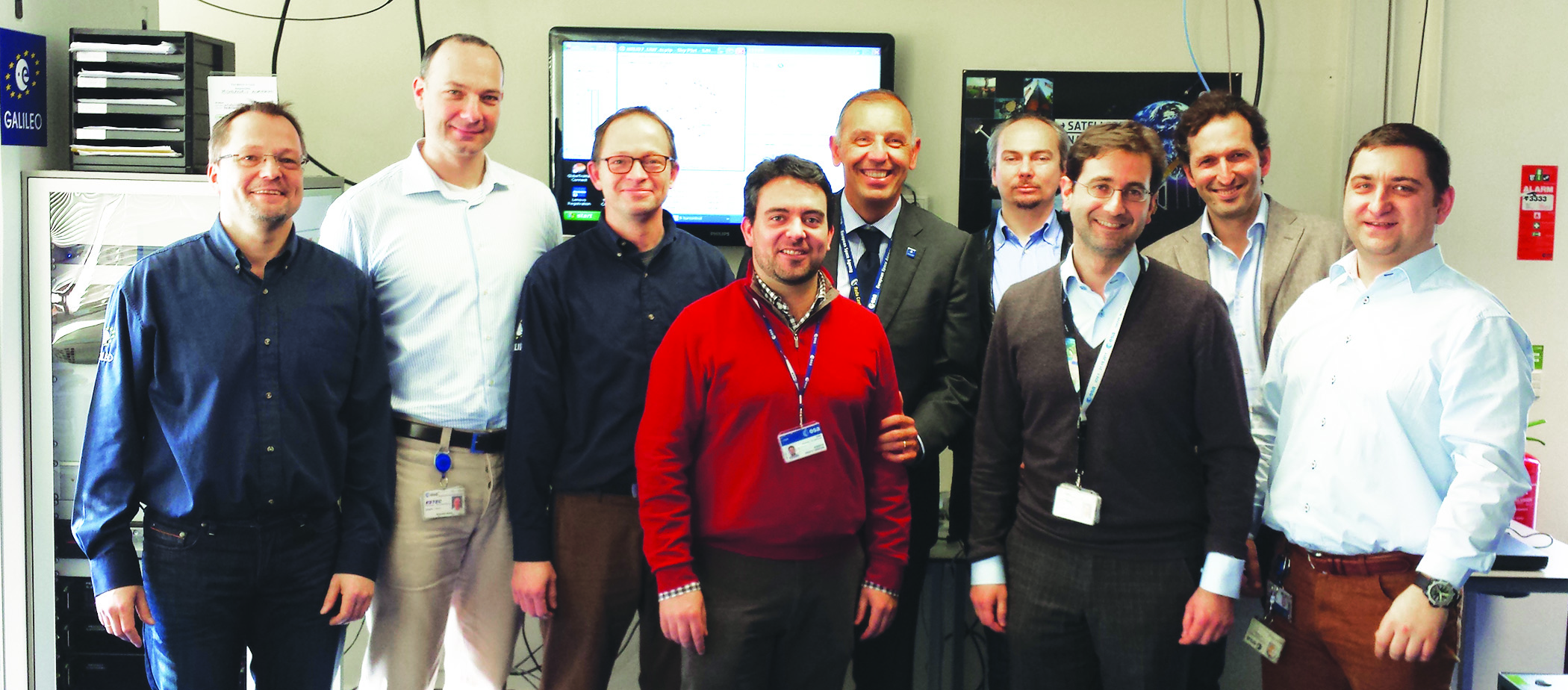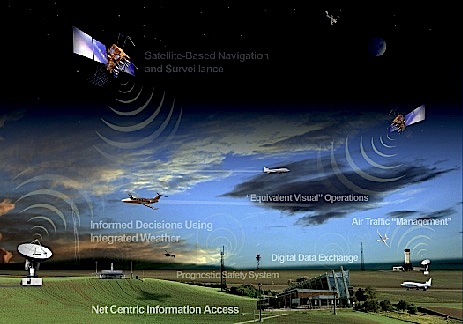 ESA Galileo IOV Test campaign authors, from left: Jörg Hahn, Stefano Binda, Edward Breeuwer, Roberto Prieto-Cerdeira, Marco Falcone, Alexander Mudrak, Gustavo Lopez- Risueño, Francisco Javier Gonzalez Martinez, and Daniel Blonski.
ESA Galileo IOV Test campaign authors, from left: Jörg Hahn, Stefano Binda, Edward Breeuwer, Roberto Prieto-Cerdeira, Marco Falcone, Alexander Mudrak, Gustavo Lopez- Risueño, Francisco Javier Gonzalez Martinez, and Daniel Blonski.The objective of the IOV phase was to launch the first four operational Galileo satellites and to deploy the first version of a completely new ground segment. During this phase, the European Space Agency (ESA) needed to validate — in the operational environment — all space, ground, and user components and their interfaces, prior to full system deployment. With the assistance of industry partners, ESA had to analyze the performance of the Galileo system and its components with the objective to refine the full operational capability (FOC) system.
The objective of the IOV phase was to launch the first four operational Galileo satellites and to deploy the first version of a completely new ground segment. During this phase, the European Space Agency (ESA) needed to validate — in the operational environment — all space, ground, and user components and their interfaces, prior to full system deployment. With the assistance of industry partners, ESA had to analyze the performance of the Galileo system and its components with the objective to refine the full operational capability (FOC) system.
The Galileo In-Orbit Validation (IOV) Test Campaign officially started on May 14 and was completed on October 31, 2013. This article describes the methods, facilities, and performance results of this successful test campaign for Galileo.
Many Resources, Many Contributors
The de facto kick-off of the IOV campaign had already occurred on March 12 when for the first time a position fix was performed with Galileo Test User receivers based at ESA/ESTEC in Noordwijk, The Netherlands. This positioning used a navigation message generated by the Galileo Ground Mission Segment and uploaded for the first time through the mission uplink stations to all four spacecraft simultaneously. (See the article by M. Falcone et alia listed in the Additional Resources section near the end of this article.)
The test campaign that followed employed facilities spread all around Europe with five months of continuous navigation, timing, and PVT performance validation campaigns at the industrial premises of ThalesAleniaSpace (TAS-I) in Rome, Italy, and EADS Astrium in Ottobrunn, Germany, at the Galileo Control Center in Fucino, Italy, and at ESA/ESTEC.
During the IOV Test Campaign Galileo ranging data were collected from:
- test user receivers for both the Open Service (OS) and the Public Regulated Service (PRS) installed at ESTEC and in TAS-I, Rome.
- an independent network of reference receivers belonging to the Time and Geodetic Validation Facility (TGVF) based at ESTEC
- the Galileo sensor stations through a dedicated interface to the GALSEE system validation platform at TASI, Rome. This interface also allowed retrieval of system internal data before uplink.
In addition to these resources, dedicated mobile vans equipped with OS and PRS test user receivers both at ESTEC and TAS-I in Rome were collecting mobile data from more than 10,000 kilometers of road tests all together.
In November 2013 the test campaign was completed with the first Galileo OS and PRS aeronautical campaign using the Metro-2 aircraft belonging to NLR Dutch aerospace laboratories, the same aircraft that was used for the first GPS and SBAS trials in Europe.
In addition to the validation campaign addressing navigation, a twomonth search-and-rescue (SAR) validation campaign has been carried out using facilities at the French Space Agency CNES, in Toulouse, France; a dedicated SAR ground station in Maspalomas, Canary Islands, Spain; and at ESTEC.
Evaluation of the SAR localization performance requires simultaneous transmissions from four satellites with SAR transponders on board. As only two Galileo IOV spacecraft are equipped with such transponders, two GPS satellites equipped with Distress Alerting Satellite System (DASS) transponders were used to complement the Galileo broadcasts.
Distress signals generated by test beacons at CNES, Toulouse, and ESTEC were received by the Galileo and GPS satellites and downlinked to an operational medium Earth orbit local user terminal (MEOLUT) based in Maspalomas, and an experimental MEOLUT based at CNES. Data from both MEOLUTs were collected and analyzed by CNES.
Open Service Dual- Frequency Position and Ranging Accuracy
Position accuracy has been analyzed during periods when all four Galileo satellites were in radiovisibility. The receiver determined position solutions at user level are shown in Figure 1 for a 10-day repeat cycle of the Galileo constellation. The position fixes were achieved in a dual frequency E1b-E5a scenario where the geometry has been constrained for a geometric dilution of precision (GDOP) better or equal to 10. The measured horizontal accuracy is better than eight meters (95%) and the vertical accuracy is better than nine meters (95%).
The Galileo system contribution to the position accuracy is the so-called signal-In-space error (SISE). For the dual-frequency user the most important SISE contributions are the satellite orbit and clock prediction errors. Those errors have been analyzed for the period in May and June 2013 when the primary timing source on the satellites was a passive hydrogen maser (PHM) and from the period August 19 to September 2013, when the prime clock was a rubidium atomic frequency standard (RAFS).
To obtain the SISE, the clock error is combined with the orbit error and then projected into the worst user direction. Table 1 shows results for a prediction window of 100 minutes, as this is the targeted maximum age of data for the navigation message before being refreshed by a new message.
The performance based on PHM and RAFS for a latency of the navigation message of 100 minutes is quite similar in the IOV configuration where the estimation error is limited by the number of satellites. Instead, for prediction times beyond 100 minutes the PHM provides better performance. Figure 2 shows the errors of transmitted messages during August 2013 when the satellite prime clock alternated between PHM and RAFS. Most of the data have an age below 100 minutes, but for the few cases where the age of data becomes older the PHM estimation error remains constant, while for the RAFS it diverges.
The limited infrastructure deployment still makes the SISE performance sensitive to outages in the system. Figure 3 shows the evolution of the error during a period when the PHM was the prime clock. The best 95% value is approximately two meters, but, as can be seen in the middle of the plot, when a transmission outage occurred of GSAT0104 the error increased to three meters. Performance and robustness will steadily increase with any satellite launch and ground segment extension, until the full FOC deployment.
In addition to the SISE discussed previously, the user equivalent range error (UERE) budget contains user receiver–related errors (multipath and receiver noise) and, for single-frequency (SF) users, the broadcast Group delay (BGD) error and the residual error of the Galileo single-frequency correction model (based on NeQuick G). For estimating the troposphere effects on the positioning, the ESA “Blind” model (which excludes meteorological measurements such as pressure, temperature, and humidity) was used, which is independent from the Galileo system. (For details on the ESA Blind model and NeQuick G, see the articles by A. Martelluci et alia and R. Orus-Perez et alia listed in the Additional Resources section near the end of this article.)
The resulting UERE budget has been analyzed in various dynamic conditions (static, pedestrian, and vehicle) for OS and PRS. The mobile data have all been collected using the vans driving at different speeds. For OS, single-frequency scenarios (SF) were based on the reception of E1b/c, E5a, and E5b. Dual-frequency scenarios (DF) included E1-E5a and E1-E5b. Tracking was based on the pilot channel due to its higher robustness.
Figure 4 shows the receiver contributions to the UERE (thermal noise, multipath and interference) for each type of OS signal in a low dynamic scenario (<40km/h) aggregated for all IOV satellites and for the period from May to July, 2014. As it can be seen, the receiver-related error remains below 0.5 meter for the composite binary offset carrier (CBOC) signal, below 0.8 meter for BPSK(10).
Figure 5 presents the total UERE for a test user receiver tracking the different OS signals and also DF E1-E5a. For the latter, the aggregate error is below two meters.
In November 2014, a series of 3 flights was performed to demonstrate for the first time the usage of GALILEO for aeronautical users and the total UERE was also found to be below two meters, as shown in Figure 6. The curves are less smooth due to the limited number of measurements. Nevertheless the trend observed for terrestrial users was confirmed for aeronautical users for UERE and PVT.
Open Service Single-Frequency Position and Ranging Accuracy
For SF users the navigation message contains two types of parameters to improve performance:
- a broadcast group delay (BGD) to compensate for the differential hardware delays between the two frequencies
- dedicated parameters be used in the Galileo receiver ionospheric correction model based on the adaptation of a climatological three-dimensional electron density model: NeQuick G.
Off-line data analysis shows that, after applying the broadcast BGD values, a residual error of 30 centimeters remains for the SF user.
The NeQuick G model has shown very good performance. Analysis of data collected from a global network of stations shows that the absolute RMS ionospheric error for the period of analysis (March-August) was around 1.3 meters when using the Galileo model; in comparison when using GPS Klobuchar the error was 1.9 meters (with an absolute difference between both models at equatorial latitudes well beyond 1 meter). An example of the level of correction for the Galileo NeQuick G and the GPS Klobuchar model are provided in Figure 7.
The UEREs for the single-frequency users as shown in Figure 4 and Figure 5 are much lower than expected because of the good performance of the NeQuick model.
Timing Accuracy
Galileo provides its users both precise positioning and timing information. It enables access to Universal Coordinated Time (UTC), the international time reference, and, as a contribution to interoperability with GPS, the system disseminates the Galileo-GPS Time Offset (GGTO).
Galileo System Time (GST) is a physical internal time reference that is closely steered to UTC modulo 1 second (i.e. the fractional offset is tightly controlled, but the leap seconds are not introduced in GST). The Galileo navigation message includes GST-UTC conversion parameters: the total number of leap seconds (i.e. GST-UTC integer offset), announcements of new leap seconds with the associated date, fractional GSTUTC time and frequency offsets. This enables user equipment to estimate the offset of the local clock versus UTC and timestamp the data in UTC if necessary.
Prediction of GST-UTC offset and computation of GST steering to UTC is performed by the Galileo Time Validation Facility (TVF), which teams up several European timing laboratories: Istituto Nazionale di Ricerca Metrologica (Italy), National Physical Laboratory (UK) (in IOV), Observatoire de Paris (France), Physikalisch-Technische Bundesanstalt (PTFGermany), Real Instituto y Observatorio de la Armada (Spain), Swedish National Testing and Research Institute (Sweden).
The team of European timing labs also validated the GST performance versus UTC (see Figure 8). In the period from May 1 to September 31, 2013, the offset between the GST physical realization and UTC never exceeded 7.3 nanoseconds. UTC dissemination performance was validated using calibrated Galileo timing receivers deployed at European timing laboratories. This allowed measurement of the offset between
UTC disseminated by Galileo (UTC(SIS)) and the local UTC(k) realization at the contributing timing laboratories. These data were further corrected for the offset between UTC(k) and the rapid UTC solution, UTCr, an official BIPM product closely approximating UTC.
Figure 9 shows the offset between the disseminated UTC(SIS) and rapid UTC in December 2013. During the depicted period in December 2013 time frame the UTC dissemination error was well below 10 nanoseconds.
Galileo-GPS Time Offset
GST has a zero integer offset to GPSTime, and both timescales are closely steered to UTC. However, a residual offset between these two timescales appears at the nanosecond level. During the IOV campaign (and also presently), the Galileo Precise Time Facility (PTF) computed GGTO based on the two-way time and frequency transfer (TWSTFT) and GPS common view between PTF and the U.S. Naval Observatory. This value was broadcast in the Galileo navigation message.
The verification of the accuracy of the broadcast GGTO relied on calibrated combined Galileo-GPS receivers deployed at European timing laboratories. These receivers enabled us to measure Galileo-GPS Time Offset at the user level by receiving both GPS and Galileo signals and comparing it to the GGTO broadcast by Galileo.
Figure 10 shows both broadcast and measured GGTO in the period November 25 – December 6, 2013. During this period, the accuracy of the broadcast GGTO was 7.1 nanoseconds with respect to the offset measured directly at the user level.
In the future, the broadcast Galileo GGTO will be determined using a combined Galileo-GPS receiver, which will further improve the accuracy of this parameter.
SAR Localization Performance
Galileo IOV search and rescue performance has been analyzed in terms of the following metrics:
- distress localization accuracy for the periods when there were four satellites in view (GSAT0103 and -0104 + two GPS satellites equipped with a SAR transponder)
- emergency alerting time and detection rate. In addition, three key intermediate performance parameters have been characterized and used for the prediction of SAR performance in the final configuration: time-of-arrival (ToA), frequency-of-arrival (FoA) and channel throughput of valid alert messages.
Figure 11 shows the SAR localization accuracy achieved by processing the distress signals generated and uplinked by the test beacons at CNES and ESTEC and received by the four antennas of the MEOLUT at Maspalomas.
Almost 95 percent of the SAR position determinations are accurate to within five kilometers from the true position of the beacon (which is the system requirement) and approximately 77 percent within a two-kilometer radius. The predictions of performance in the final configuration, based on measured key intermediate performance parameters, indicate that on average more than 99 percent of locations will be more accurate than two kilometers.
Practically all alerts have been detected within one-and-a-half minutes.
Outlook for performance of Final Operational Capability
A key objective of the IOV test campaign was to establish confidence that FOC requirements will be met. Therefore the result s shown above have been used to establish FOC representative UERE budgets, considering the currently planned ground and satellite infrastructure deployment as well as the geometry of the final Galileo Constellation. Table 2 provides an overview of expected Open Service performance for typical users based on IOV measured results.
Conclusion
The IOV test campaign has demonstrated that the currently deployed Galileo satellites and ground infrastructure work very well. Position accuracy has been shown to be better than eight meters horizontal and nine meters vertical (95%). This is expected to improve in the coming years with the further deployment of the constellation. Also the SAR infrastructure works very well, already providing localization accuracy of five kilometers (95%).
This now concludes the IOV phase that began in 2004 and has proven to be a major stepping stone to the successful completion of the Galileo system, which will continue in 2014 with the first launches of the FOC satellites.
Acknowledgments
The IOV system is the result of the work performed by major European satellite and ground segment manufactures: EADS Astrium Germany with the main subcontractor ThalesAleniaSpace Italy have built the four IOV satellites. AstriumUK has been prime contractor for the Ground Control Segment and ThalesAleniaSpace France has been prime contractor for the Ground Mission Segment.
The IOV campaign has been performed under ESA leadership (Galileo Project Office and Technical Directorate) together with the following industry teams:
- The system team led by ThalesAlenia Space-Italy with main subcontractors EADS Astrium Germany for signal, system performance, and external interfaces, and Thales Communication Systems France for security.
- The operations team led by Space Opal with main subcontractors DLR Gfr for spacecraft operations and GCS ground operations and Telespazio for GMS ground operations and payload security unit monitoring and control.
CNES, the French Space Agency, has supported the SAR data collection and analysis.
Additional Resources
[1] Falcone, M., and S. Binda, E. Breeuwer, J. Hahn, E. Spinelli, F. Gonzalez, G. Lopez Risueno, P. Giordano, R. Swinden, G. Galluzzo, and A. Hedquist, “Galileo on Its Own: First Position Fix,” Inside GNSS, March/April 2013, pp. 50–53, 71
[2] Martellucci, A., and R. Prieto-Cerdeira, “Review of tropospheric, ionospheric and multipath data and models for Global Navigation Satellite Systems,” Proceedings of the 3rd European Conference on Antennas and Propagation, EuCAP 2009, Berlin, March 23-27, 2009
[3] Orus-Perez, R., Prieto-Cerdeira, R., Arbesser- Rastburg, B. “The Galileo single-frequency ionospheric correction and positioning observed near the solar cycle 24 maximum”, in Proceedings of 4th International Colloquium Scientific & Fundamental Aspects of the Galileo Programme, Prague, December 2013.




